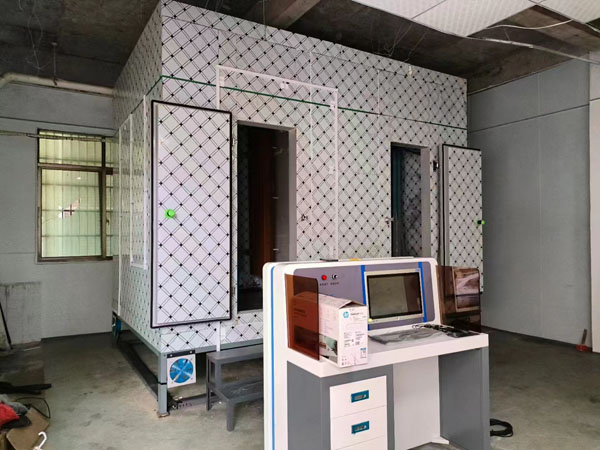Testing equipment for thermal insulation performance of doors and windows

PIC-(Testing equipment for thermal insulation performance of doors and windows)
1、 Introduction
With the intensification of the global energy crisis and the improvement of environmental awareness, building energy conservation has become a global focus of attention. In building energy conservation, doors and windows are an important component of the building envelope structure, and their insulation performance has a direct impact on the energy consumption of the building. Therefore, accurate and efficient testing of the insulation performance of doors and windows is particularly important. The importance of the door and window insulation performance tester, as a device specifically used to evaluate the insulation performance of building doors and windows, is self-evident.
2、 Product Overview
The door and window insulation performance tester is a professional equipment based on the principle of stable heat transfer, which uses the calibration hot box method to test the insulation performance of door and window specimens. This device can simulate indoor and outdoor climate conditions in winter, accurately measure key indicators such as heat transfer coefficient and thermal resistance of door and window specimens, and provide important basis for quality control and energy-saving evaluation of doors and windows.
The door and window insulation performance tester has the characteristics of high-precision measurement, fully automated operation, strong flexibility, good safety, and high degree of intelligence. It is suitable for various types of building exterior doors and windows, including casement windows, sliding windows, swing doors, sliding doors, etc. By using this device, rapid and accurate evaluation of the insulation performance of doors and windows can be achieved, providing strong support for the technological progress and product quality improvement of the door and window industry.
3、 Product features
Thermal insulation performance test: able to simulate indoor and outdoor climate conditions in winter, and accurately measure key indicators such as heat transfer coefficient and thermal resistance value of door and window specimens.
Data collection and analysis: The equipment is equipped with a fully automatic data collection system, which can record various data during the testing process in real time, and analyze and process them through professional software to generate detailed testing reports.
Real time monitoring: The device has a real-time monitoring system that can display real-time changes in parameters such as temperature, humidity, and power during the testing process, ensuring the accuracy and stability of the testing process.
4、 Product features
High precision measurement: Using high-precision sensors and measurement technology to ensure the accuracy and reliability of test results.
Fully automated operation: The equipment achieves full automation operation, including temperature control, data collection, result calculation, etc., greatly improving testing efficiency.
Strong flexibility: It can be flexibly configured and adjusted according to different types of doors and windows and testing needs to meet diverse testing needs.
Good safety: The equipment structure is designed reasonably, and the safety protection measures are complete to ensure the safety and reliability of the testing process.
High degree of intelligence: equipped with advanced control systems and data processing software, it can achieve intelligent control and data analysis, improve the accuracy and efficiency of testing.
5、 Working principle
The door and window insulation performance tester is based on the principle of stable heat transfer and uses the calibration hot box method to test the insulation performance of door and window specimens. The specific working principle is as follows:
Install the door and window specimens between the hot and cold boxes to ensure the sealing between the specimens and the hot and cold boxes.
Simulate winter indoor and outdoor climate conditions by adjusting the temperature of the hot and cold boxes through the control system.
Under stable testing conditions, real-time temperature, humidity, power and other parameter data on both sides of the specimen are collected through high-precision sensors.
Based on the collected data, key indicators such as heat transfer coefficient and thermal resistance value of door and window specimens are calculated using professional software.
6、 Product composition
The thermal insulation performance tester for doors and windows mainly consists of the following parts:
Hot box: Simulates indoor climate conditions in winter and controls temperature through a heating device.
Cold box: Simulates winter outdoor climate conditions and controls temperature through refrigeration devices.
Test piece frame: used for installing door and window test pieces to ensure the sealing between the test piece and the hot and cold boxes.
Temperature measurement system: including temperature sensors, humidity sensors, etc., used for real-time collection of temperature, humidity and other parameter data on both sides of the specimen.
Control system: including control software, PLC controller, etc., used to control the temperature of the hot box and cold box, data acquisition and analysis, etc.
7、 Technical parameters
1. Temperature control range of the hot box: 10-50 ℃
Measurement accuracy: 0.2 ℃
Temperature control fluctuation range: 0.01~0.1 ℃
2. Cold box temperature control range: -22~-10 ℃
Measurement accuracy: 0.2 ℃
Temperature control fluctuation range: 0.01~0.2 ℃
3. Hot box power measurement and control range: 10-1500W
Accuracy: 0.2%
4. Steady state power fluctuation range of the hot box: ≤ 1%
5. Testing efficiency:
(1) Intermittent specimen testing: refers to the intermittent testing of a specimen during an indefinite period, with a total time consumption of approximately 9-10 hours per specimen
(2) Continuous specimen testing: refers to the total time required to continuously test the same or different specimens during a certain period of time, which is approximately 8-9 hours per specimen
6. Door and window test piece size: selected within the range of 1500mm x 1500mm to 1800mm x 2100mm
7. Power distribution: AC 380V, power ≤ 15kW, three-phase five wire system
8. Equipment dimensions: length x width x height (mm) 3900 x 2700 x 3500
9. Equipment installation and usage space: length x width x height (mm) 6000 x 4200 x 4000
8、 Compliant with standards
The design, manufacturing, and testing process of the door and window insulation performance tester all comply with the following national or industry standards:
GB/T 8484-2020 Classification and Testing Methods for Thermal Insulation Performance of Building External Doors and Windows
GB/T13475-2008 "Determination of steady-state heat transfer properties of insulation - Calibration and protective hot box method"
ISO 8990:2013 "Determination of thermal performance of building doors and windows"
9、 Application field
The thermal insulation performance tester for doors and windows is widely used in the following fields:
Door and window manufacturing enterprises: used for product research and development, quality control, and new product evaluation to ensure that products meet energy-saving requirements.
Research unit: Basic research and new technology development for the insulation performance of doors and windows.
Third party testing agencies: provide objective and fair testing services for the insulation performance of doors and windows for governments, consumers, and others.
Building energy efficiency evaluation agency: used for energy efficiency evaluation and acceptance of building projects.
10、 Scope of application and limitations
Scope of application: Suitable for various types of building exterior doors and windows, including casement windows, sliding windows, swing doors, sliding doors, etc.
Suitable for door and window specimens of different sizes and specifications.
Limitation: The equipment should be placed in a laboratory environment with stable power supply, water source, and drainage.
The laboratory should meet certain temperature and humidity requirements to ensure the normal operation of equipment and the accuracy of test results.
Operation and maintenance should be carried out by professional personnel to avoid equipment damage or inaccurate test results caused by non professional operations.
11、 Operation and Maintenance
Operation steps: Before starting up, check if all components of the equipment are intact and ensure that the power supply, water source, etc. are connected properly.
Install door and window specimens according to testing requirements to ensure the sealing between the specimens and the hot and cold boxes.
Start the testing program by controlling the software to set testing parameters.
Monitor changes in parameters such as temperature, humidity, and power during the testing process to ensure stability and accuracy.
After the test is completed, automatically generate a test report and save the data.
Maintenance and upkeep: Regularly clean and inspect the equipment to ensure the normal operation of all components.
Regularly check the accuracy and sensitivity of the sensor, and calibrate it if necessary.
Regularly upgrade and maintain the control system and software to ensure the progressiveness and stability of the equipment.





















